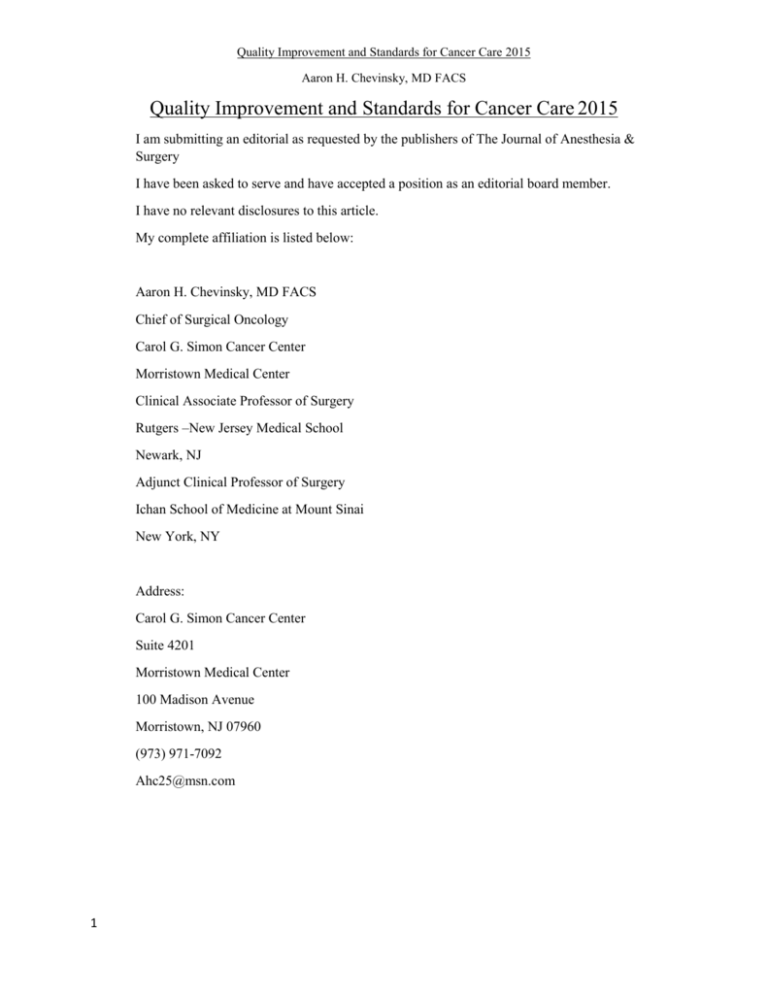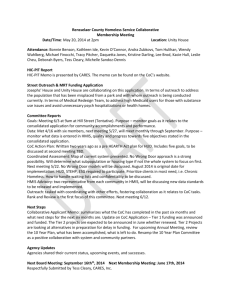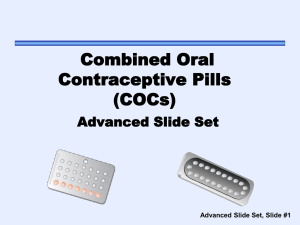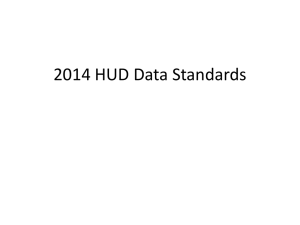Quality Improvement and Standards for Cancer Care 2015
advertisement

Quality Improvement and Standards for Cancer Care 2015 Aaron H. Chevinsky, MD FACS Quality Improvement and Standards for Cancer Care 2015 I am submitting an editorial as requested by the publishers of The Journal of Anesthesia & Surgery I have been asked to serve and have accepted a position as an editorial board member. I have no relevant disclosures to this article. My complete affiliation is listed below: Aaron H. Chevinsky, MD FACS Chief of Surgical Oncology Carol G. Simon Cancer Center Morristown Medical Center Clinical Associate Professor of Surgery Rutgers –New Jersey Medical School Newark, NJ Adjunct Clinical Professor of Surgery Ichan School of Medicine at Mount Sinai New York, NY Address: Carol G. Simon Cancer Center Suite 4201 Morristown Medical Center 100 Madison Avenue Morristown, NJ 07960 (973) 971-7092 Ahc25@msn.com 1 Quality Improvement and Standards for Cancer Care 2015 Aaron H. Chevinsky, MD FACS Quality Improvement and Standards for Cancer Care 2015 As a newly appointed member of the editorial board of the Journal of Anesthesia & Surgery, I have been asked to prepare an editorial for the inaugural edition. I have decided to devote this editorial to the current quality standards which are being monitored for the treatment of cancer as defined by the Commission on Cancer (COC) of the American College of Surgeons (ACS), the National Quality Forum (NQF) and Choosing Wisely® (CW) an initiative of the American Board of Internal Medicine (ABIM). How the quality of cancer care is defined varies greatly depending on who is doing the measuring and what the information derived will be used for. If you define quality by patient standards it may relate to symptom control, treatment efficacy and lack of complications or side effects; if you define it by the physician it may be how well the patient responds to their treatment regimen and how likely the treatment is to eradicate the cancer; by institutional standards it may be defined as how closely the treatment team adheres to the established treatment guidelines and protocols; and the insurance companies may define it as how economically the care was rendered. The most basic definition of quality cancer care can be defined by long-term survival, timeliness and success of treatment, adherence to evidence based guidelines and the overall patient satisfaction. Many external organizations and groups are attempting to measure, quantify and rank medical care including the US News and World Reports, which publishes lists of medical institutions and ranks them locally, regionally and nationally, the American College of Surgeons National Surgical Quality Improvement Program (NSQIP) and the University Health Systems Consortium (UHC). In order to understand the rankings, we need to understand the criteria which are being measured (which are not in any way uniform amongst the groups conducting the reviews). Most cancer centers and cancer programs in the United States are accredited by the COC, the organization which is in charge of promoting quality cancer care in the United States, and which visits hospital and cancer programs periodically to assess their adherence to their guidelines. The COC also collects, and will soon make available to the public, data on adherence to guidelines and outcomes from individual hospitals, systems and cancer centers. In this editorial, I will discuss the current and future guidelines and data collected by the COC through its National Cancer Data Base (NCDB), Cancer Program Practice Profile Reports (C3PR) and the Rapid Quality Reporting System (RQRS). In addition, I will discuss the quality initiatives which are being promoted by the Choosing Wisely® group as it pertains to cancer care. The current guidelines which pertain to cancer care in COC approved and accredited hospitals are predominately centered on breast and colorectal cancer, although guidelines for stomach and lung cancer are soon to be implemented. These guidelines attempt to measure the quality of care which is provided to 2 Quality Improvement and Standards for Cancer Care 2015 Aaron H. Chevinsky, MD FACS cancer patients by monitoring a variety of surgical, medical and radiation therapy milestones which need to be met in a timely manner. The Choosing Wisely® campaign, also touches on the appropriateness of cancer care, and the diagnostic techniques used to diagnose and plan cancer therapy for many of the commonly treated cancers. I will be listing the COC measures, the CW recommendations, and will denote those which are current (C) and those which will be implemented in the future (F): Breast Cancer Guidelines (1-3) 1. Radiation therapy must be administered to all women under age 70 having breast conserving therapy for breast cancer within 1 year (365 days) of diagnosis (C – COC/RQRS, NQF 219). a. Target level is 85% compliance. 2. Combination chemotherapy is considered or administered within 4 months (120 days) of breast cancer surgery in women under age 70 with American Joint Committee on Cancer (AJCC) Stage T1cM0N0, Stage II or Stage III hormone receptor negative invasive breast cancer (C – COC/RQRS, NQF 0559). a. Target level is 85% compliance. 3. Tamoxifen or an aromatase inhibitor is considered or administered within 1 year (365 days) of diagnosis of AJCC Stage T1cM0N0, Stage II or Stage III hormone receptor positive invasive breast cancer (C – COC/RQRS, NQF 0220). a. Target Level is 85% Compliance. 4. Radiation therapy is considered or administered within 1 year (365 days) for women undergoing a mastectomy for invasive breast cancer with 4 or more positive (cancer involved) lymph nodes (F – COC). 5. Image or palpation guided needle biopsy (core or fine needle aspirate) is done to establish the diagnosis of breast cancer prior to initiating therapy (to avoid the need for open surgical biopsy) (F – COC, CW). a. Target level is 80% compliance. 6. Breast conservation (lumpectomy) is implemented as primary surgical therapy for women with AJCC clinical Stage 0, I or II breast cancer (F – COC). a. Target level is 60% 7. Sentinel lymph node biopsy should be performed instead of axillary lymph node dissection in patients with AJCC clinical Stage I and II invasive breast cancer (CW). a. If sentinel lymph node(s) are negative, no further lymph node dissection is needed. 3 Quality Improvement and Standards for Cancer Care 2015 Aaron H. Chevinsky, MD FACS b. If minimal axillary disease is present, limited microscopically to 1 or 2 axillary lymph nodes, and the patient will be getting radiation therapy after breast conservation surgery, no additional lymph node dissection is needed. 8. Do not perform staging PET, CT or radionuclide bone scans in asymptomatic patients with early stage breast cancer with a low risk of metastasis (CW). 9. Do not perform routine surveillance testing (biomarkers) or imaging (PET, CT, and radionuclide bone scans) for asymptomatic individuals who have been treated for breast cancer with curative intent (CW). Colorectal Cancer Guidelines (1-3) 1. A minimum of 12 lymph nodes are to be removed and pathologically examined in patients undergoing curative colon cancer surgery (does not apply to AJCC Stage IV colon cancer or any stage of rectal cancer)(C – COC/RQRS, NQF 0225). a. Target level is 85% compliance 2. Adjuvant chemotherapy is considered or administered within 4 months (120 days) in patients under age 80 with AJCC Stage III (lymph node positive) resected colon cancer (C – COC/RQRS, NQF 0223). a. Target level is 85% compliance. 3. Radiation therapy is considered or administered within 6 months (180 days) of diagnosis in patients under age 80 with rectal cancer AJCC Stage T4N0M0 or Stage III receiving surgical resection (C – COC/RQRS). 4. Avoid colorectal screening tests (colonoscopy, sigmoidoscopy…) in asymptomatic patients with less than 10 year life expectancy and no family or personal history of colorectal neoplasia (CW). Stomach Cancer (1) 1. At least 15 lymph nodes should be removed and pathologically examined during surgical resection of invasive gastric cancer (F – COC). Lung Cancer (1) 1. At least 10 lymph nodes should be removed and pathologically examined during surgical resection of non-small cell lung cancer AJCC stages IA, IB, IIA and IIB (F – COC). 4 Quality Improvement and Standards for Cancer Care 2015 Aaron H. Chevinsky, MD FACS 2. Systemic chemotherapy is administered within 4 months (120 days) pre-operatively or 6 months (180 days) post-operatively for surgically resected cases with pathologic lymph node positive (pN1) and (pN2) non-small cell lung cancer (F – COC). In addition to the guidelines listed above, volume and mortality data will be prospectively collected for patients undergoing radical cystectomy, esophagectomy, gastrectomy, pancreatectomy, rectal and lung cancer resections (1). New guidelines are also being implemented which will require (by 2015-2017) universal cancer psychological distress screening, mandatory preparation of a survivorship care plan for all patients receiving cancer care and a record of treatment to be provided to each patient after completion of initial therapy, integration of palliative and end of life care into all cancer programs and the development and implementation of nurse navigation for common cancer sites (1). These are some of the current and new guidelines for cancer care which have been and will be implemented. This data is already being collected by your institution and reported to the Commission on Cancer. Some of these will (and is) publicly available. The purpose of collecting and monitoring this data is to assure that all patients being treated at COC approved institutions provide the same high level of cancer care throughout the country. I will continue to update you on these guidelines and the timeline for implementation as more information becomes available. 5 Quality Improvement and Standards for Cancer Care 2015 Aaron H. Chevinsky, MD FACS References 1. Commission on Cancer of the American College of Surgeons – www.facs.org 2. National Quality Forum – www.qualityforum.org 3. Choosing Wisely® - www.choosingwisely.org 6






